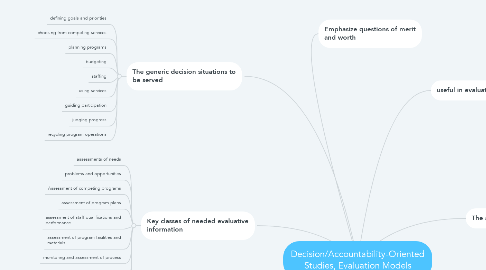Decision/Accountability-Oriented Studies, Evaluation Models
by Luis Alberto Porras Páez


1. Emphasize questions of merit and worth
2. The generic decision situations to be served
2.1. defining goals and priorities
2.2. choosing from competing services
2.3. planning programs
2.4. budgeting
2.5. staffing
2.6. using services
2.7. guiding participation
2.8. judging progress
2.9. recycling program operations
3. Key classes of needed evaluative information
3.1. assessments of needs
3.2. problems and opportunities
3.3. Assessment of competing programs
3.4. assessment of program plans
3.5. assessment of staff qualifications and performance
3.6. assessment of program facilities and materials
3.7. monitoring and assessment of process
3.8. assessment of intended and unintended and short-range and long-range outcomes
3.9. assessment of costeffectiveness
4. Methods used
4.1. surveys
4.2. needs assessments
4.3. case studies
4.4. advocate teams
4.5. observations
4.6. interviews
4.7. resident evaluators
4.8. quasi-experimental and experimental designs
5. Is applicable in cases where program staff and other stakeholders want
5.1. formative evaluation
5.2. summative evaluation
6. The advance organizers include
6.1. Decisions Makers /Stakeholders
6.1.1. beneficiaries
6.1.2. parents/guardians
6.1.3. service providers
6.1.4. administrators
6.1.5. program consultants
6.1.6. support personnel
6.1.7. policymakers
6.1.8. funding authorities
6.1.9. citizens
6.2. projected decision situations
6.3. program accountability requirements
7. The evaluator should establish and engage a representative stakeholder advisory panel to
7.1. help define evaluation questions
7.2. shape evaluation plans
7.3. review draft reports
7.4. help disseminate findings
8. Provide the evaluation framework for
8.1. Internal Evaluation
8.1.1. commission an independent metaevaluation of the inside evaluator’s work

